- Bernard Preston homepage
- Bread
- Bread Experiments
Bread experiments
Bread experiments enable you to bake an even better loaf; it is fun too.
For me, as a busy person there are two non-negotiables. First it must be a nutritious, tasty loaf and secondly it should be relatively quick; gone are the days when I had hours to commit to kneading. And approaching the last years of life, I am totally consumed with our food being good for us.
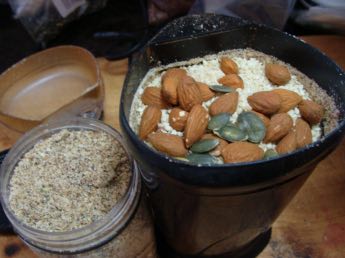
This page was last updated by Bernard Preston on 3rd March, 2025.
Everyone in their seventies knows that something will get them eventually; but life is so good that I have no desire to die unnecessarily long before my time, simply because I did not, or would not eat nutritious-food.
That means the dough must be made from whole-flour; the refined, bland stuff from the supermarket is the right way to constipation, obesity and an early demise.
Most of us have a sluggish bowel so plenty of fibre is vital; use only 100 percent wholemeal. There are no bread experiments with the non-negotiables.
Proline
Proline is the amino-acid in gluten that makes some of us allergic to wheat.
There are many things you can play with. One is when to add the yeast.
Traditionally one places the yeast at the bottom of the baking-tin, then the flour and lastly the liquid fraction.
But recently I've been experimenting with sourdough to make our bread more digestible; the longer the bacteria and natural-yeasts are in contact with your wholemeal the greater the percentage of the nasty proline chains that are broken down.
So try preparing your sourdough without the yeast initially. Just leave it on the counter for a few hours, or even overnight in or out of the refrigerator; and then sprinkle it on top and put the mixture in the bread-machine as usual.
There are many different sourdough starters on the web, so you can play with them; most use rye-flour for the lactobacillus that digests the proline. I like to use raw honey and spring water too that has no chlorine. Try a few bread experiments.
I would use rye flour if the unrefined wholemeal was available; it is not and I find that our freshly-ground wheat works perfectly well.
Secondly try putting varying the amount of water in your dough. Too much and it tends to sink a bit but you will have a lovely moist-loaf; add less and it will rise better but may be rather dry on the second day.
Temperature
Temperature is a vitally important factor, one which I confess I have been slow to appreciate. Every summer my loaf would not rise properly. This year I used cold water from the fridge instead of tepid. It has made an incredible difference to both the texture of the bread and the size of the loaf. I am able to use just half a teaspoon of yeast, much less than previously.
Seeds
Thirdly work with different seeds; do grind them first by the way or they will not be digested in the gut. I always use flax for its high omega 3 content; that is anti-inflammatory and important to the DC. Sesame too is a wonderful source of lignans. Then you can play with sunflower, poppy and pumpkin; and others.
You could grind some nuts into the seed mix too; I like half a dozen almonds but pecans or any other would do. Preferably freshly-cracked as they go rancid very quickly; from a vacuum packed container is okay.
Try adding the ground-seeds after an hour; you will be surprised at the difference.
Nuts and seeds are amongst the non-negotiables if we want to enjoy long, healthy lives. How you get them down is up to you. Finally, after much experimenting I have concluded that they adversely affect the texture of our bread. So now they go into smoothies instead.
Herb-infused loaf
Use your hands to lightly crush two fresh bay-leaves, 2 sprigs of thyme and 1 of rosemary into a small pan; add the normal butter or coconut oil and cook over medium heat for about five minutes, stirring periodically to prevent burning.
Remove the herbs, allow to cool and use the infused-oil in the usual way for baking.
Use that same pan then to cook your breakfast; scrambled eggs or whatever.
Poolish pizza-dough
I haven't made this yet as I generally am not fond of pizza; it gives me a very uncomfortable feeling in the tum. However, Eva explains very beautifully how a pre-ferment deals with gluten and phytate issues making it far more digestible.
She gives two options at poolish pizza dough.
A poolish means using a very small amount of dried yeast, a levain with your sourdough starter. Both take 24-hours but neither need a lot of your time; you are simply giving the culture space to pre-digest the gluten.
Perhaps pizza will make a comeback to our table.
It has; see the result at sourdough pizza crust.
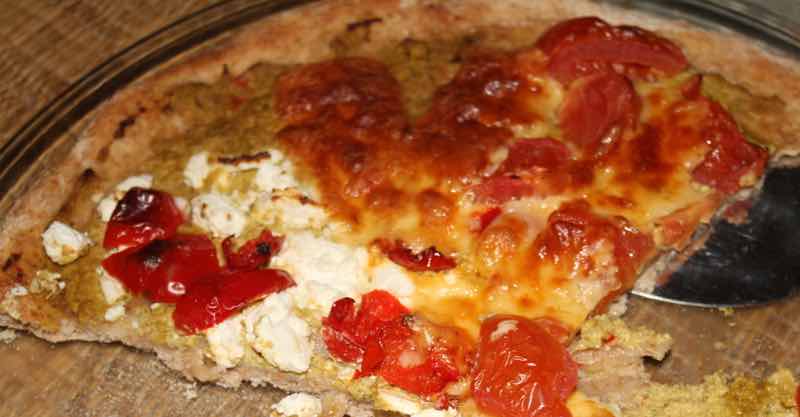
Phytates
Are phytates bad, you may be asking? They are natural chemicals found in whole foods that reduce the glycemic-index of starches; how quickly they are turned into sugar in the blood stream. Ask any diabetic and they will tell you how important that is.
There are phytates in the wholemeal flour and in the seeds and nuts you add. The lignans, for example, help prevent breast tumours and the anti-inflammatory omega 3 in flax is especially important. These whole foods protect the initima of the blood vessels keeping them clean and free from atherosclerosis. Enhance this process with your bread experiments but reduce the negative effect they have on mineral absorption.
There is a downside though. Phytic-acid binds to minerals, particularly zinc but also iron and calcium, reducing the absorption. This effect is reduced by a long soak in the sourdough mixture.
Copy and paste "are phytates bad," lignans or anti-inflammatory omega 3 into Site Search above for more information.
Prime the starter
Prime your starter with some wholegrain meal, fork vigorously and add some water; a couple hours before preparing the dough.
During the initial phase of fermentation the yeast needs plenty of oxygen to multiply rapidly; later it switches to anaerobic producing the acids we love. Getting as much air into the starter as possible will give you a much better rise.
Lemon juice
Adding acids[4], according to Bakerpedia, by reaction with alkaline substances in the dough releases more carbon dioxide and extends the shelf-life of your bread.
I discovered this quite by accident after reading a recipe for beer-bread which also called for the addition of vinegar. I decided to use lemon-juice instead, since we have a plentiful supply; voila it has definitely improved our sourdough. I am experimenting to find the optimal amount; currently it is haphazard.
Normally I do not recommend using the juice of lemons; rather the whole fruit since more than half of the important nutrients like vitamin C and citric-acid are to be found in the pulp; here I make an exception.
Bread experiments
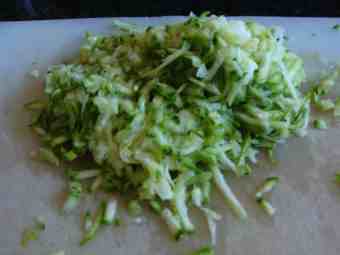
Bread experiments are about fine-tuning your baking. If your machine has different times, try both the four and five-hour; we prefer the latter.
See if adding honey instead of sugar makes a noteworthy difference; and olive oil in place of butter. In fact a little sour-cream is lovely too.
One of the most important experiments for me is adding different forms of protein; they lower the glycemic-index.
Homemade hummus is traditional fare in our home; it really makes a green salad, so when it has seen better days the balance goes into our dough. Actually I now add a teaspoon or two daily; it has improved both the taste and texture.
Newsletter
Our newsletter is entitled "create a cyan zone" at your home, preserving both yourself and Mother Earth for future generations; and the family too, of course. We promise not to spam you with daily emails promoting various products. You may get an occasional nudge to buy one of my books.
Here are the back issues.
- Lifestyle and ideal body weight
- What are ultra-processed foods?
- Investing in long-term health
- Diseases from plastic exposure
- Intensive lifestyle management for obesity has limited value
- A world largely devoid of Parkinson's Disease
- The impact of friendly bacteria in the tum on the prevention of cancer
- There's a hole in the bucket
- Everyone is talking about weight loss drugs
- Pull the sweet tooth
- If you suffer from heartburn plant a susu
- Refined maize meal and stunting
- Should agriculture and industry get priority for water and electricity?
- Nature is calling
- Mill your own flour
- Bake your own sourdough bread
- Microplastics from our water
- Alternative types of water storage
- Wear your clothes out
- Comfort foods
- Create a bee-friendly environment
- Go to bed slightly hungry
- Keep bees
- Blue zone folk are religious
- Reduce plastic waste
- Family is important
- What can go in compost?
- Grow broad beans for longevity
- Harvest and store sunshine
- Blue zone exercise
- Harvest and store your rainwater
- Create a cyan zone at your home
Then you can add different types of fat; I have settled on butter and old cream as favourites as I am not afraid of cholesterol. With all the salads we eat, ours is dangerously low so some added dairy is not a fear.
Coconut butter is another good option.
You could add milk instead of water; and even beat in an egg. Butter is back and the trans-fat margarines are definitely out; bad stuff.
Always
make it nutritious; and keep it simple. Add some chopped herbs or olives, for example. Rosemary and thyme are my favourites but sweet
basil is great too.
Then you might like to cheat just a little; I add a tablespoon of regular bread flour. True, it is had a lot of the goodies removed but it makes a less coarse loaf. That makes up only 5 percent of the whole.
World standards vary enormously. In the Netherlands bread that is described as whole grain must be 100 percent; but in Germany it is only 90.
But in the United States in essence only 50 percent of the grain must be whole meal.
And so of course there are many ways you can make bread experiments; it is good to make notes, not forgetting to add the conclusions.
Delayed salt method
Salt slows down the fermentation of your dough; it inhibits the natural development of the gluten.
Try a little bread experiment in which you add the salt near the end of the initial resting phase; say about 3/4 of an hour after you set the machine on.
Retain a few TBSP of the water in which to dissolve it.
Lift the baking tin out of the oven, and give the paddle a few turns to mix the salt throughout the dough.
And now for a bit of controversy; this just is not working for me. The texture of the dough isn't nearly as nice. So now I add the salt water first with the sourdough pre-ferment, mix it up with the paddle and I am getting a much better loaf. More bread experiments are needed.
The basis of this I have learned is that salt and yeast are enemies but I have worked out a different way.
I add the salt first and the yeast at the very last, on a little extra added flour to keep it initially away from the dough. It works, the crumb is much better.
Premixed dough
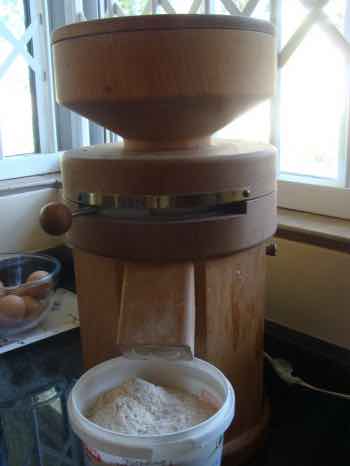
There is interesting research showing that dough exposed to the bacteria and wild yeasts for a longer period are better tolerated by our colons; the offending proline is better digested. This is just another bread experiment at this stage.
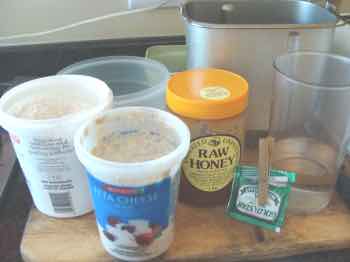
Tufts university recommends this loaf that I have taken the liberty to adapt to include sourdough and the bread machine.
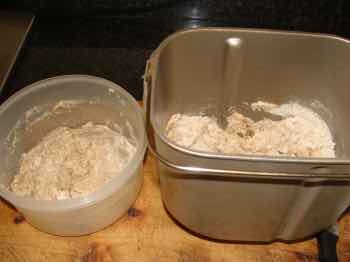
- In your bread-maker oven dish mix half the water, one teaspoon of
honey and let it stand for a few minutes; add half the 100% bread meal
and using the paddle, mix the ingredients. Cover with a recycled
plastic bag and allow to stand overnight at room temperature.
- Mix
the remaining flour, water and the sourdough starter; and a teaspoon of raw
honey preferably, in a separate bowl and stir. Again cover and leave
overnight. This in fact is known as a levain.
- Next morning add the sourdough mix from the
second step to your oven-dish mixture; then a teaspoon of salt, a dollop of butter and another 5ml of honey. Include a shot of
homemade hummus to turn it into a low GI loaf.
- Turn on your bread machine to its normal five hour cycle.
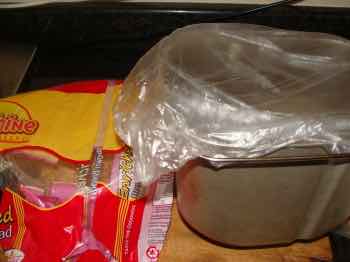
The Tufts method is long and involved; I doubt neither you nor I have the time, nourishing though it may be. And I do not believe in baking one loaf of bread in the normal oven; it is wasteful of precious electricity. Their way you will do only now and then; it is arduous. Mine will take only five-minutes one evening and three more the next morning; you can manage that daily.
Butter is back and, furthermore, researchers at the Spanish Ciberobn centre, using new techniques with biomarkers, say they have conclusively shown that dairy consumption is not associated with increased cardiovascular risk.
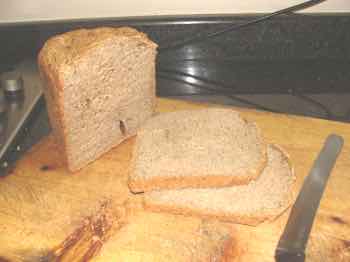
Here is an update. I follow now a similar process but which is much less labour intensive; I place all the flour and sourdough mixture in the baking dish with the water and leave it overnight. Next morning I add the salt, hummus and yeast. It is just as good and a lot easier.
100% flour
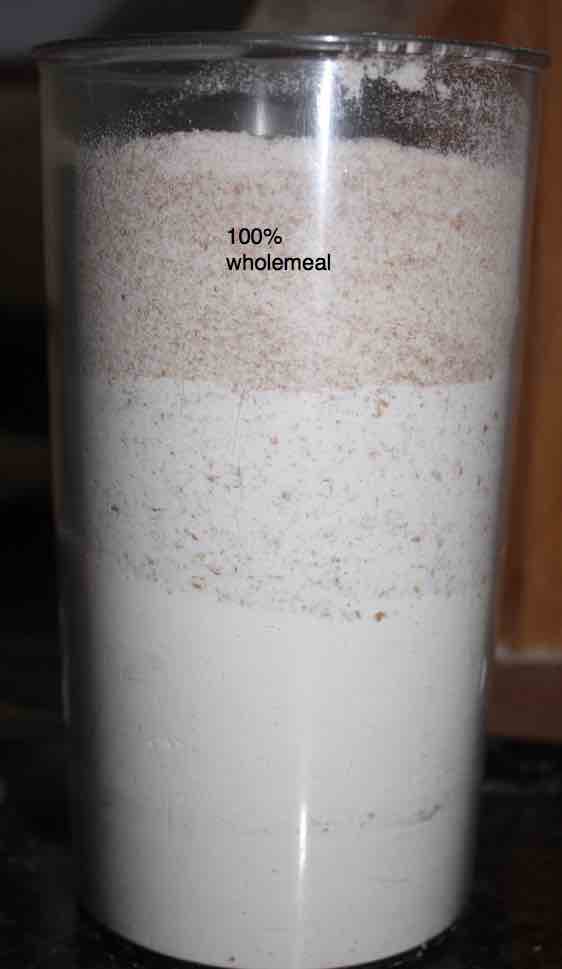
100% flour is one of the non-negotiables remember. Unfortunately to improve their profits and to remove the oils, millers are allowed to label their product as wholemeal provided no more than 40 percent of the goodies have been extracted; the best ingredients as it turns out, giving thought to your bread experiments.
It is not acceptable in my book that the millers can deceive us like that as we want all the bran, vitamins and minerals; and especially the important fatty acids. Do not try such bread experiments; only 100 percent wholemeal. If you cannot get it, seriously consider a wheat-mill; they are expensive but ours is thirty years old and perfect. It is used daily without a hiccup.
On the subject of grinders, there are two good alternatives to our old Hawo; the Mockmill and the KoMo, using a composite instead of real wood. They have come down significantly in price; now around $350 and the flour is finer than ever.
Research published in JAMA reveals that adding smart bran to a refined grain has no value.
Low glycemic index
Low glycemic index bread is vital; whilst your wholemeal loaf, especially with added protein has a moderate GI, the white slices, rolls and scones really are total junk. They cause the blood sugar to soar and that means obesity and the ever-present threat of diabetes and metabolic syndrome; keep them for high and holy days. It is not worth the time and effort to make bread experiments with poor quality ingredients.
Does your family favour any bread experiments you make with white flour? They will love them and want more, but refuse to do it. In fact never make a start; it is the beginning of trouble for them, and you are sowing the seeds.
I am in the midst of a series of short stories by women; it is a lovely book of insights into those from Venus. Last night's lament was how the menopause caused her to become grossly obese, just like her mother. But one little dietary tidbit slipped through; they both loved chocolate donuts. You can never stop at one only.
They have an extremely high glycemic index; the recipe was designed to undermine the American woman. It has succeeded spectacularly well.
It is our experience that the tongue can be retrained but it is a spiritual enterprise. Whether it is the words we say or the love of refined baked goods, it is a fire that corrupts the whole person.
One small experiment has been a great success, and that is to drop a tablespoon or two of our easy butternut squash soup into the dough; remember to reduce the liquid a little, or it will sink. It makes for a smoother texture and interesting flavour especially as I like to add a little curry powder. The fat from the coconut cream further lowers the glycemic index.
Fermentation time
A longer fermentation time certainly means more sour flavour and better predigestion of both protein and the starch.
In a controversial research project done in Israel, scientists followed a local tradition, with an initial fermentation of 1 hour at 24oC, followed by a retarded further processing of 8 hours at 4oC.
Their conclusion was that the broad spectrum of the microbiome in the gut had a far more important influence on a broad array of clinical parameters than whether white flour or 98% wholemeal was used in baking sourdough bread[3]. Highlights are as follows.
- Crossover trial yielded no differential clinical effect when comparing sourdough and white bread.
- The microbiome accurately predicts the glycemic response to bread.
There are obviously many critics of this unexpected finding, in particular that the crossover trial consisted only of two one-week interventions. Our take home from the project is that use of a probiotic such as kefir on a regularly basis is vitally important.
Indigestion and heartburn
Bread has long given me indigestion and heartburn. I cannot classify this as one of our bread experiments; it happened by chance. I forgot to add the yeast last week. Imagine my surprise when soup for supper demanded a slice of bread, and neither of us had the slightest discomfort.
In the past a slice or two with soup for supper was a definite harbinger of a bad night to come for me. Now we are doing bread experiments with less yeast; my initial reaction is that a heavier loaf with less yeast is giving less tummy troubles.
Finally though in these bread experiments causing indigestion, I have discovered that reestablishing the normal flora in the colon using these kefir benefits has completely solved the problem.
It is still all to be confirmed but I recommend that you too make bread experiments if you suffer from indigestion and heartburn. There are so many tiny variables with baking that can make a huge difference to the taste and texture; and their role in the happy tum.
This easy zucchini bread recipe is yet another.
Temperature
For years and I'm not exaggerating, I misconstrued that too much water was what caused my loaf to sink abominably; it affected the crumb too, for the worse.
Then I read of the importance of temperature on the yeast; it needs to be as close to 28*C as possible. If the carbon-dioxide is produced too quickly, before the gluten structure is strong enough to contain it, then the loaf will collapse.
Two things were happening. The flour directly from the mill was really quite warm; and I was using hot water to dissolve the salt.
Once I changed to freezing the wheat before milling, and using only cold water, the shape and texture of my loaf improved magically. This little gem I gleaned from Andrew Whitley's book called "Bread Matters." It should be on the shelf of every serious baker.
Andrew is the driving force behind the real bread movement in the UK.
Persistence
Persistence in adversity and failure is essential; for no obvious reason last summer our bread flopped every day. I have no idea what the reason was; I thought it was the yeast, my wife blamed the humidity. Beating the starter vigorously when adding flour to incorporate plenty of air has solved the problem.
Again for no reason, a month later all returned to normal; and I still have no idea why. I shudder to think that I might have quit had I a little less persistence.
Reducing the yeast in our sourdough and increasing the honey and butter have helped too. What about the amount of salt, and when you add it? At the end of the day, remember that dough has a mind of its own, often undecipherable.
Yeast does seem like humans to have a sweet-tooth. Sufficient honey preferably or a teaspoon of sugar will not kill, is important.
Start tasting different loaves and soon you will learn there is real and fake bread. The latter is so bland and often will leave you with heartburn and a bellyache.
- Go from bread experiments to foods that lower cholesterol.
- Easy sourdough bread recipe.
- Vegan seed bread.
Fat
I have alternated between using butter and non-deodorised coconut cream and frankly cannot tell the difference.
Although more expensive, I favour the vegetable coconut. I recommend you experiment with the amount of fat you want to add to the dough.
Honey
I have stuttered on this subject. Certainly, unless you're a beekeeper, I would not use high quality raw honey in your bread; it would ruin it. So I've suggested using sugar in the past.
However my bread rises better with honey so I am back to using our best grade, simply because it is all we have. You will have to do your bread experiments.
You can get commercial honey from the supermarket but frankly I would not mess with it; it is such a heat-labile product and so easily adulterated.
If you want to use honey in your kitchen, find a local beekeeper and buy a year's supply of raw honey straight from the bottling tank.
Yeast
If your loaf sinks in the centre, try using less yeast; I now use about 1/2 of a teaspoon in our sourdough-bread.
However you may find your yeast has a sweet tooth; try adding double the amount of honey and see if you get a better loaf.
You may even need to increase the amount of dried-yeast.
Sticking in the oven dish
Sometimes it is quite difficult to get the loaf out of the oven-dish; it sticks.
We have tried different experiments; three things have helped.
- Let the oven dish cool for five or more minutes.
- Make sure that the oven dish and paddle are absolutely clean before adding the dough. If there is even a little of yesterday's bread stuck to the pan, you will struggle to get the loaf out.
A crochet needle with a hook is handy for getting the paddle out of the loaf; make sure you do not roughen it with the bread knife.
Baking time
If you like a hard crust then use the full five hours but we have been experimenting with a softer texture in our bread experiments; just turn off the oven a few minutes early, leaving the baking-tin in situ for the full time.
Kefir as a fermenting agent
Sourdough breads not only taste better, to my mind anyway, but are also more nutritious; the bacteria and yeasts in the fermenting-agent help to predigest the gluten, making it more friendly for those who are intolerant to this very important wheat protein. It gives the bread dough its unique properties.
There are probably hundreds of sourdough fermenting agents. I am experimenting with using the probiotic known as kefir; it is the magic that cured my fifteen-year bellyache of a heliocobacter infection in my stomach that was stubbornly resistant to medication.
Teaming with bacteria and yeasts it is proving to be a wonderful fermenting agent in our artisan bread recipe.
Dark rye or wheat flour in your starter?
For nearly ten years I have been using rye flour to feed my pre-ferment. But recently for unknown reasons it stopped bubbling actively. So I added a tablespoon of the 100% wholewheat flour that I use for baking bread. Voila and the starter has come back to life.
I am now wondering if I need that rye at all. It is difficult to get the unrefined flour, and it is a lot more expensive. More bread experiments are in the offing.
From a serious baker
I am saying that I have a newish method of baking myself which is a no-knead bread. I use Shipton Flour which is an amazing mill. Bagged and ground since at the moment I don't have the space to hold half a ton.
I start the week before by making a "Poolish." It is effectively a new starter which sits in the fridge for 4 days. It gives a more mature flavour and colour to the loaf but not sour. My standard mix is 80/20 organic flour to wholemeal rye and I add loads of goodies like pumpkin-seeds and malt flakes.
I use a tiny bit of yeast, salt and tip the poolish into the mixing bowl and combine with water. Let the mixture sit for 24hrs. Lightly oil a cast-iron pot, flour the whole pot liberally and tip the mixture in. It takes about two hours to prove and then stick it in the oven on full whack for 55 minutes with the lid on.
Listen to your body
One of the most important experiments is to learn to listen to our bodies. Now that we have carbs galore at our green home in midsummer some inner voice tells me to eat less bread.
You can have too much of a good thing; even an excess of resistant starch may be over-indulgent.
Bernard Preston
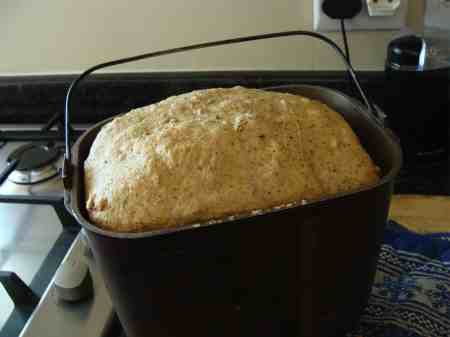
Bernard Preston loves to bake, and these bread experiments keep it fun; but always it is nutritious-flour make into low glycemic-index dough. High GI food is kept for high and holy days.
For many years I had one bad habit, learned from my Lebanese-mother; using sugar with the yeast. Imagine in one of my bread experiments my surprise when, using only honey instead, that the loaf rose so beautifully, and the texture was also much improved.
The fungi are also allergic to sugar it would seem.
The Lord is my chosen portion and my cup; thou holdest my lot.
The lines have fallen for me in pleasant places; yea, I have a goodly heritage.
Psalm 16
Then he is a semi-retired DC but kept busy every afternoon, flies gliders on Saturdays and is a layminister in the local church. Remember the body is the temple of the Holy Spirit, says he; do not abuse the dwelling place of Almighty God. In any case it will cause you a lot of pain and cut your life short.
When browsing use right click and Open Link in New Tab, or you may get a bad gateway signal.
Did you find this page interesting? How about forwarding it to a friendly book or food junkie? Better still, a social media tick would help.
- Bernard Preston homepage
- Bread
- Bread Experiments
Address:
56 Groenekloof Rd,
Hilton, KZN
South Africa
Website:
https://www.bernard-preston.com